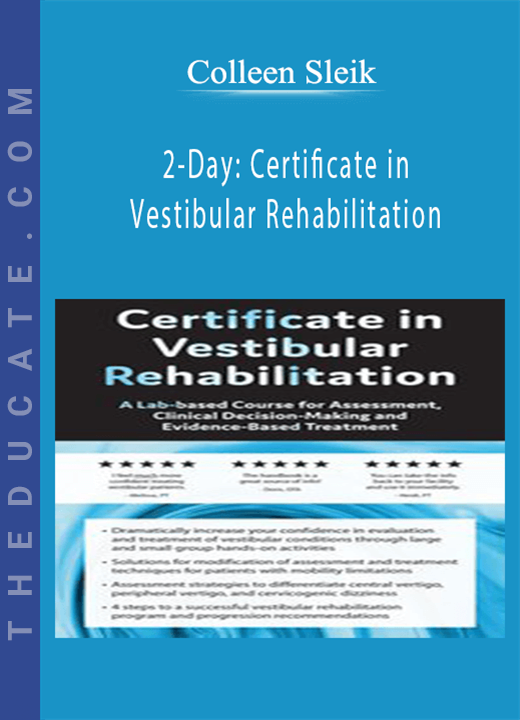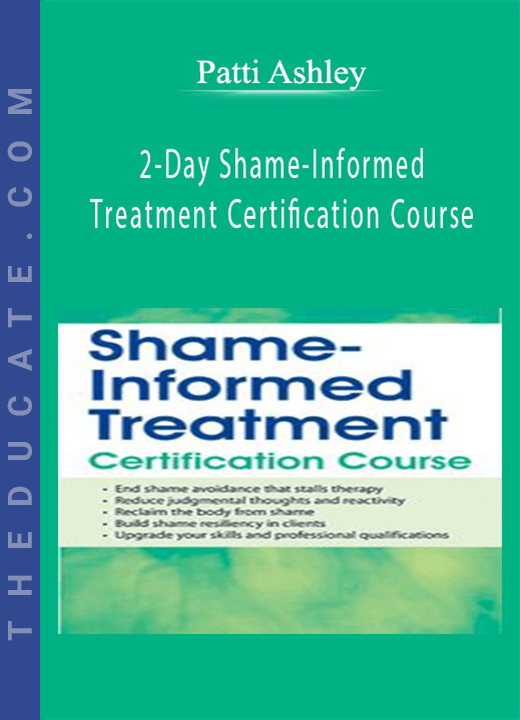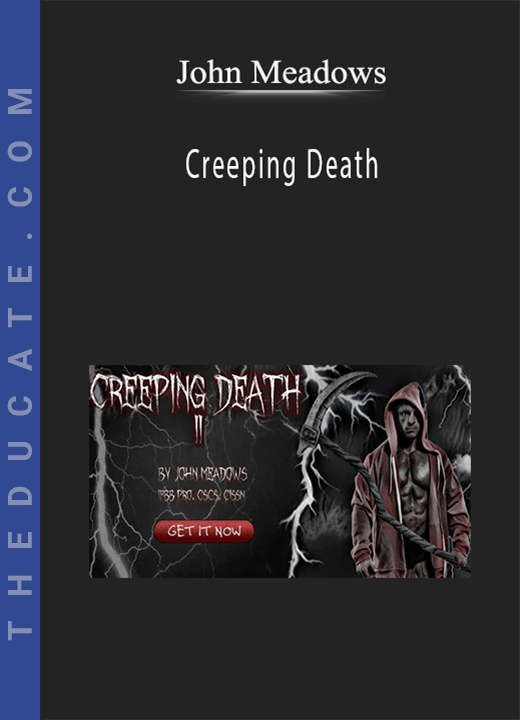Description

- Faculty:
- Colleen Sleik
- Duration:
- 11 Hours 52 Minutes
- Format:
- Audio and Video
- Copyright:
- Mar 06, 2019
- Determine the involved canal based on assessment findings
- Evaluate findings that indicate multiple canal involvement
- Choose appropriate modifications to positioning as required based on patient mobility
- Analyze various assessment techniques and findings specific to central vertigo
- Recognize key subjective clues and objective findings indicating cervicogenic dizziness
- Differentiate BPPV from other peripheral diagnoses
- Where to start, how to proceed and components to consider if treatment is not progressing as expected
- Patient education tips to improve compliance with treatment and home exercise programs
- Recognize factors that may affect success of canalith repositioning maneuvers and techniques to improve effectiveness
- Differentiate additional treatment requirements for patients with central diagnoses, cervicogenic dizziness and post-concussion syndrome
- Identify factors affecting progression
- Learn how to overcome barriers to success with vestibular rehabilitation
- Choose evidence-based functional assessment measures from Vestibular EDGE/Academy of Neurologic Physical Therapy recommendations
- Select functional measures that will direct each of the 4 areas of treatment for vestibular rehabilitation
- Gain confidence through practice: Learn how to incorporate new assessment and treatment techniques
- Apply clinical decision-making to actual patient case studiesa
Colleen Sleik – 2-Day: Certificate in Vestibular Rehabilitation: A Lab-Based Course for Assessment, Clinical Decision-Making and Evidence-Based Treatment
Description
Colleen Sleik PT, DPT, OCS, NCS, began her journey into the specialized care of vestibular rehabilitation patients after evaluating a patient that she felt ill equipped to help. She needed to know more. Recognizing and treating BPPV itself is quite straightforward. However, the care becomes much more complex for patients that are experiencing something that was initially thought to be BPPV or for those who have multiple conditions impacting their overall presentation. Advanced learning is required to understand how the systems function as a whole. This course was developed with these challenging patients in mind.
The course begins with assessment and treatment techniques for BPPV, including a lab component to practice technique, hand positioning, and patient-specific modifications. You will become skilled to better recognize BPPV and subsequently recognize the presentations that do not fit the BPPV pattern. Further assessment and treatment of the non-BPPV diagnoses will also be addressed through functional assessments and treatment progressions.
You will walk out with a deeper understanding of assessment, treatment techniques, patient-specific modifications, and differential diagnosis skills for the dizzy patient. Take your skills to a new level when you can pinpoint the areas where therapy can intervene to promote the desired functional gains for patients and the strategies to appropriately progress patients through each of those areas.
Handouts
| Manual – Certificate in Vestibular Rehabilitation (5.84 MB) | 175 Pages | Available after Purchase |
| Instructions for ASHA Credit – SELF STUDY ONLY – 03/06&07/19 (38.5 KB) | Available after Purchase |
Outline
DIFFERENTIATE SPECIFIC CANAL INVOLVEMENT FOR BPPV AND MULTIPLE CANAL BPPV
EVALUATION OF FINDINGS FOR CENTRAL, PERIPHERAL, AND CERVICOGENIC DIZZINESS
BPPV TREATMENT OF ONE OR MULTIPLE CANALS
WHAT IF IT’S NOT BPPV: IDENTIFY THE 4 AREAS OF TREATMENT FOR ALL VESTIBULAR PATIENTS
EVIDENCE-BASED FUNCTIONAL ASSESSMENT TOOLS FOR VESTIBULAR PATIENTS
COURSE LABS
Faculty

Colleen Sleik, PT, DPT, OCS, NCS Related seminars and products: 6
Focus On Function Physical Therapy PC
Colleen Sleik, PT, DPT, OCS, NCS, is a licensed physical therapist, specializing in the treatment of patients with vestibular disorders when other forms of medical management have failed. Dr. Sleik founded a private practice in 2010 with the primary focus of treating patients with vestibular conditions. She continues to work as a specialist at Dickenson Rehab Services where more than 90% of her caseload consists of patients with vestibular and balance disorders.
Dr. Sleik graduated from The College of St. Catherine with a Master’s in physical therapy. She earned a transitional Doctor of physical therapy degree through The University of St. Augustine, Florida, and completed the Competency-Based Vestibular Rehabilitation course through Emory University in Atlanta, Georgia. In addition to board-certification as an Orthopaedic Clinical Specialist and Neurologic Clinical Specialist, Dr. Sleik is a member of the American Physical Therapy Association, including the Academy of Neurologic Physical Therapists, and the Vestibular Special Interest Group.
She began teaching continuing education courses in vestibular rehabilitation with the purpose of improving clinicians’ knowledge in the specialty of vestibular rehabilitation and ultimately improving the quality of patient care. Dr. Sleik’s goal as a clinician is to provide her patients with the best care available for return to daily function with minimal limitations, while also providing the tools for long-term self-management of symptoms.
Speaker Disclosures:
Financial: Colleen Sleik has an employment relationship with Dickinson County Health Care System; and Aegis Therapies, Golden Living Center. She receives a speaking honorarium from PESI, Inc.
Non-financial: Colleen Sleik is a member of the American Physical Therapy Association.






3 reviews for Colleen Sleik – 2-Day: Certificate in Vestibular Rehabilitation: A Lab-Based Course for Assessment, Clinical Decision-Making and Evidence-Based Treatment
There are no reviews yet.